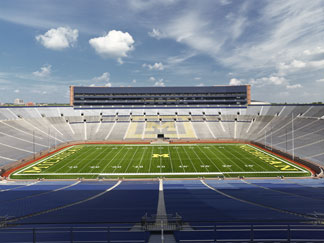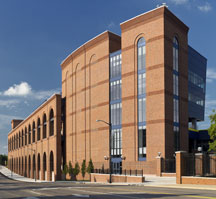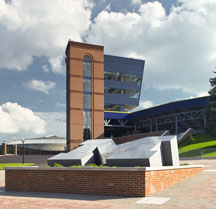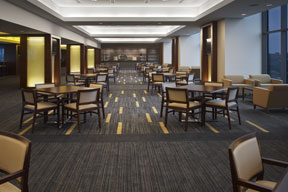U-M Goes Big With Stadium Renovation

Photos provided by Feinknopf, courtesy of HNTB.
ANN ARBOR, Mich. — The Big House just got a little bigger.
Michigan Stadium at University of Michigan now boasts a capacity of 109,901, making it the largest stadium by capacity in the United States and the third largest in the world. The centerpiece of U-M’s athletics facilities, Michigan Stadium recently wrapped up a three-year, $226 million renovation project that added more than 2,000 seats and upgraded fan amenities.
The renovation is part of an overhaul of U-M’s athletic facilities over the last ten years that has included building a new soccer stadium, constructing an indoor football practice facility, renovating the baseball/softball complex, and several other campus projects.
Very little has been done to upgrade Michigan Stadium since it originally debuted in 1927 says Joe Parker, U-M’s senior associate athletics director.
“Effectively, in many ways, [it’s] a brand new stadium,” Parker says.
“We had a facility that had served the Michigan community for 80 years but now needed a lot of upgrading to improve fan amenities,” Parker says, about the decision to renovate. “We really took a holistic approach to the project to put the stadium in a position to better serve the community for the next 30 or 40 years without needing much more done on it other than to expand again if we have to.”
Before renovations even began in the summer of 2007, contractors replaced every cubic foot of concrete in the stadium, including the  original concrete poured for the risers in 1927, and redid all of the bleacher seats.
original concrete poured for the risers in 1927, and redid all of the bleacher seats.
 original concrete poured for the risers in 1927, and redid all of the bleacher seats.
original concrete poured for the risers in 1927, and redid all of the bleacher seats.The stated goals of the renovation were to improve life safety features and the fan experience while not decreasing the capacity of the stadium or limiting opportunities for future expansions. The made-over Michigan Stadium includes 400,000 square feet of additional space, more platforms for ADA seating, wider aisles, and a greater number of restrooms and concession stands.
Most notably is the addition of premium seating — a feature The Big House didn’t have previously, says Parker. The stadium now houses 85 suites, 1,900-plus outdoor club seats, more than 250 indoor club seats, and upwards of 850 covered outdoor club seats. U-M took out some 4,000 seats in the existing bowl to make room for the additions, which included 650-plus new chairback seats.
“First off, there is a demand for those type of seating opportunities, so we wanted to create options for everyone, whether it is for someone who wants a more traditional experience of sitting in a bowl or someone who desires a higher-level experience from a club seat or suite” Parker says.
“Secondly, in order to create a project that was financially feasible, we had to build in a new revenue stream,” Parker adds. “So those 6,000 [premium] seats are really paying for the project. By doing that we didn’t have to put a surcharge on our season ticket holders, increase prices or develop some other kind of new revenue.”
Two multi-story framed structures, located on the east and west sides of the stadium house the club lounge, indoor club seats, suites, and an upgraded press box. The multi-story additions allowed for the construction of upper concourses, which increased the bowl’s overall capacity.
The changes to Michigan Stadium haven’t gone unnoticed by fans. On Sept. 4, more than 113,000 fans packed The Big House for a look at the renovations during the season opener U-M-University of Connecticut game, setting an attendance record in modern college football history.
 Tim Cahill, vice president and director of sports design at HNTB Architecture, which worked with associate architect Kallman McKinnell & Wood Architects of Boston and construction manager Barton Malow of Southfield, Mich., on the renovation, says the project has been nearly 10 years in the making.
Tim Cahill, vice president and director of sports design at HNTB Architecture, which worked with associate architect Kallman McKinnell & Wood Architects of Boston and construction manager Barton Malow of Southfield, Mich., on the renovation, says the project has been nearly 10 years in the making.“We started on this project close to a decade ago with master planning and with helping the university look at its options,” says Cahill. “From the beginning, we wanted to build the additions to blend with the rest of the campus, so we approached the stadium renovation with the architectural detailing of U-M’s other athletic facilities in mind.”
As a result, Michigan Stadium now incorporates the same type of brick and architectural arches used elsewhere on campus. HNTB also improved the facilities’ Wayfinding and added new graphics and Michigan-specific decorative elements, including plaques representing every county in the state. Fans in suites and premium seating are surrounded by big-screen televisions and have access to their own elevators. New green features include low-flow toilet fixtures and waterless urinals, Energy Star-rated rooftops, and recycled building materials.
As an addendum to the project, U-M will spend an additional $1.8 million to build permanent lights at Michigan Stadium, allowing it to host its first night game this December.
Having renovated athletic facilities at most of the Big 10 schools, HNTB has witnessed first-hand the overhaul of collegiate stadiums and arenas, and the addition of luxury areas, in order to generate greater revenue.
“You have to generate dollars with each facility to help fund the remainder of the sports you want to have on campus,” says Cahill.
The new seating is expected to generate about $12 million in revenue the first season, with the suites and premium seating creating more than $14 million annually when sold out. By early September, 65 of the 81 suites and approximately 90 percent of the 2,952 new premium seats had been leased for the full season. U-M has received some $32 million in donation commitments for naming rights to the expansion as well.

The fans, both those in the premium seating and those not, appreciate the greater number of bathrooms and concession stands, while the increase in bowl height has created a stronger acoustic environment, says Parker.
“If you were here at the home opener for the University of Connecticut game, all you saw were smiling faces, and that was the fans’ reaction to the completed project,” describes Parker. “There’s just a greater level of convenience for fans to be able to leave their seats and go grab a coke or hotdog and be back in a reasonable time, whereas before if you left your seat it was a struggle to get back without missing a lot of play.
“To see everyone experience the club seating and suites for the first time was really gratifying too, especially to watch families have that opportunity and finally understand what it meant on Michigan game day,” he adds. “That feeling went all the way to the media, who were seated in a brand new press box. They had been so accustomed to coming to Michigan Stadium and being shoehorned into a press box built in the 1950s. Now they have great sightlines to the field, wireless connections, and storage for all their gear.
“There’s really no comparison to what the experience was before to what we have now for so many people,” Parker says. “I think we’ve exceeded expectations on every level.”
